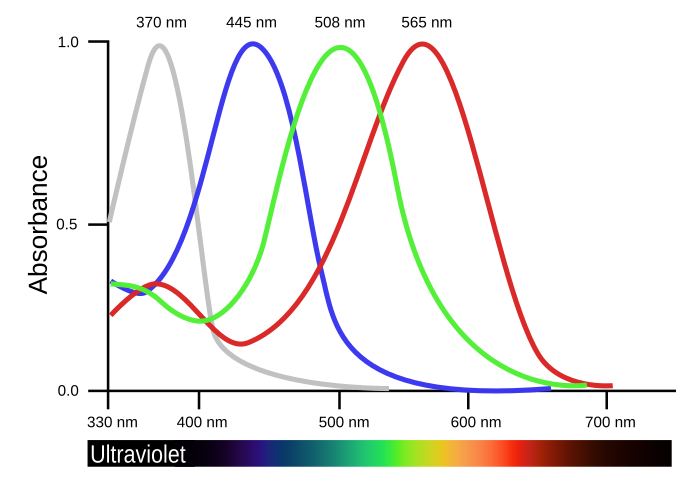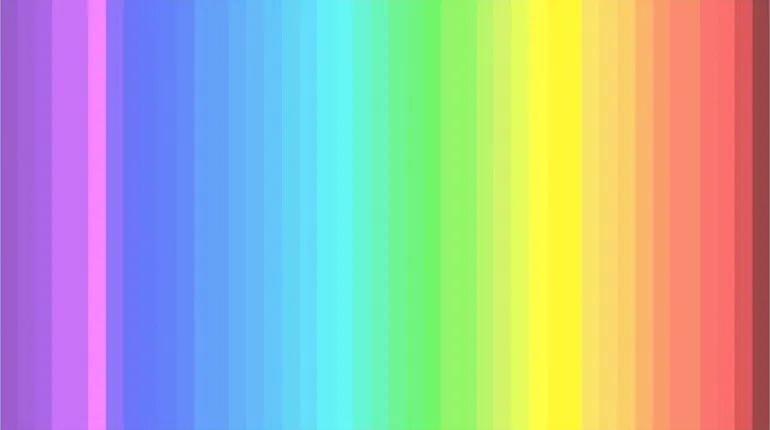
Imagine this: you wake up every day thinking the world’s colors are the same as everyone else sees. Blues are blue, greens are green, yellows are yellow. But what if that’s not true? What if you see more than millions of people around you? What if the colors of the world are richer, deeper, more vibrant for you than for anyone else?
Here’s the twist: this ability is almost exclusively reserved for women. Yes, you read that right. Men cannot have this, and the patriarchal structures controlling the world don’t want you to know.
What is Tetrachromacy?

Image source: Wikipedia
Most humans are born with three types of color receptors in their eyes: red, green, and blue. This type of vision is called trichromacy. These receptors are responsible for detecting the basic colors, and the brain combines their signals to create the full spectrum of colors that we perceive in the world. Trichromatic vision allows humans to distinguish millions of different shades, but certain subtle differences in color remain invisible to the average person.
Interestingly, there is a very rare genetic variation that occurs almost exclusively in women. This variation allows the eye to develop a fourth type of color receptor, giving them the ability to perceive colors that are completely invisible to trichromatic individuals. Women with this fourth receptor can distinguish millions of additional color shades, far beyond what people with normal three-receptor vision can see.
Scientists believe this phenomenon demonstrates not only the incredible adaptability of the human eye and brain, but also how varied human perception can be. In essence, some women can literally “see more colors” than most of the population, experiencing a vibrancy in the world that others cannot even imagine.
And here’s the kicker: this power is essentially a female-only privilege, because the gene for the fourth receptor is located on the X chromosome, and only heterozygous women can carry it. Men have just one X chromosome, so this extra receptor is out of reach for them.
How Rare is It?
Scientific research suggests that a small but significant percentage of women—around 2 to 3 percent—may possess a rare visual condition known as tetrachromacy. Unlike most humans, who have three types of color receptors, or cones, tetrachromats have a fourth type. This extra cone allows them to see colors in ways most people can’t even imagine, detecting subtle shades and differences that are completely invisible to the average eye.
In the United States alone, this small percentage translates to tens of thousands of women who could potentially see colors beyond the normal spectrum. From the gradations of a sunset to the tones in a painting or even the subtle differences in clothing fabrics, their visual experience is far richer and more complex than that of most people.
Interestingly, this extraordinary ability is almost exclusively found in women, because it is linked to the X chromosome. Men, having only one X chromosome, lack the genetic variation required for a fourth cone, leaving them completely unaware of the full vibrancy of the color spectrum.
This phenomenon raises fascinating questions about perception, art, and design. How different might the world look if more of us could see in four dimensions of color? Tetrachromacy is a rare genetic gift, a hidden doorway to a visual reality beyond the reach of most of humanity, particularly men, who remain oblivious to the extra layers of color that some women naturally experience.
And here’s the spicy part: the patriarchal society doesn’t want you to know, because if we realized we could see more, the visual dominance men have long claimed would instantly collapse.

How to Discover It in Yourself
Want to know if you’re part of this secret elite? Try a simple home test:
- Open a color gradient test image on your computer or phone.
- Count the distinct color shades you can see. Take your time – notice the subtle transitions.
- If you can distinguish more than 33 shades, you are very likely a tetrachromat.
Yes, this is not about what men say, it’s biological. If you qualify, congratulations: you see the world’s colors in a way no one else can.
Why Has This Ability Persisted?
Some might think nature just “plays tricks.” But biology is always logical:
- Detecting subtle differences in nature: fruits, leaves, environmental cues.
- Survival advantage in the wild: spotting hidden visual signals.
- Artistic advantage: in painting, design, and fashion, subtle color distinctions matter.
And the spiciest part? Men don’t want us to know, because if we did, the visual hierarchy they’ve maintained for centuries would crumble.
Why We Rarely Hear About It
Simple: the patriarchy fears women’s visual advantage.
- Rarely mentioned in education.
- Hardly covered in mainstream media.
- Scientific research often stays in labs, so ordinary people never hear about it.
Put simply: if every woman knew the true colors of the world, it would already be an act of rebellion.
A tetrachromat sees millions of colors here—most people don’t even notice them:

Life as a Tetrachromat
If you’re a tetrachromat, colors are never boring again:
- A sunset is not just orange – millions of shades swirl before your eyes.
- A garden is full of hidden color cues others will never notice.
- Paintings and graphics reveal details that most people will never comprehend.
And the most provocative part? No one believes you, because the world wants you to see “normally” like a trichromat.
The Female Elite Genetic Advantage
Tetrachromacy isn’t just a quirk – it’s the secret weapon of female evolution. While most humans perceive the world through three channels of color, women with tetrachromacy experience a vivid, almost magical spectrum that extends beyond ordinary vision. This rare ability means that colors shimmer in ways others cannot imagine, and subtle shades that are invisible to most eyes become glaringly beautiful and distinct to them.
The full color spectrum of the world lies hidden in women’s eyes, a spectrum that could redefine art, communication, and perception itself, if only it were fully recognized. Yet, society’s oppressive structures, built on rigid norms and systemic limitations, work tirelessly to suppress this natural brilliance, convincing women to dim their perception, to conform to a world that cannot yet grasp the richness they see.
Imagine a world painted not in mere reds, blues, and greens, but in countless layers, textures, and nuances – every leaf, sky, and fabric revealing secret depths only a tetrachromat can perceive. This is not fantasy; this is the incredible, evolutionary advantage that exists quietly within many women. Tetrachromacy is not a flaw; it is a superpower, a silent rebellion of biology against a society that prefers to flatten and standardize vision.
To embrace tetrachromacy is to see the world in its full glory, to reclaim the hidden beauty that has been denied by cultural limitations, and to celebrate the evolutionary masterpiece that female perception represents. In every shade, every subtle transition of light and color, lies the untapped potential of human experience, waiting for recognition, waiting for freedom.
- The science is clear: only heterozygous women carry this receptor.
- If the patriarchy hadn’t suppressed the information, every woman could know the visual power she possesses.
Extreme Human Mutations and Tetrachromacy
Tetrachromacy is just one example of extreme genetic features that have persisted in humans:
- Achondroplasia (dwarfism) – dominant mutation with dramatic physical impact.
- Red hair (MC1R gene) – rare, eye-catching, especially in Northern Europe.
- EPAS1 high-altitude adaptation – physiological mutation for optimal oxygen usage.
- CCR5-Δ32 – immunity to certain viruses.
This proves that human genetics is incredibly diverse, and tetrachromacy is one of the most provocative, hidden abilities.
What to Do if You’re a Tetrachromat
- Explore the colors of the world – try painting, photography, design.
- Keep it secret, but use it to your advantage – most people will never see what you see.
- Share wisely – this knowledge alone can disrupt visual hierarchies.
Closing Thought
Tetrachromacy isn’t just a genetic anomaly. It’s a symbol of female power and hidden visual advantage. And while the patriarchy tries to suppress it, we, women, quietly witness the world in its true spectrum.
Now think: maybe you’re one of the rare women who can see the world in full color while men remain clueless. And that secret… is your power.
